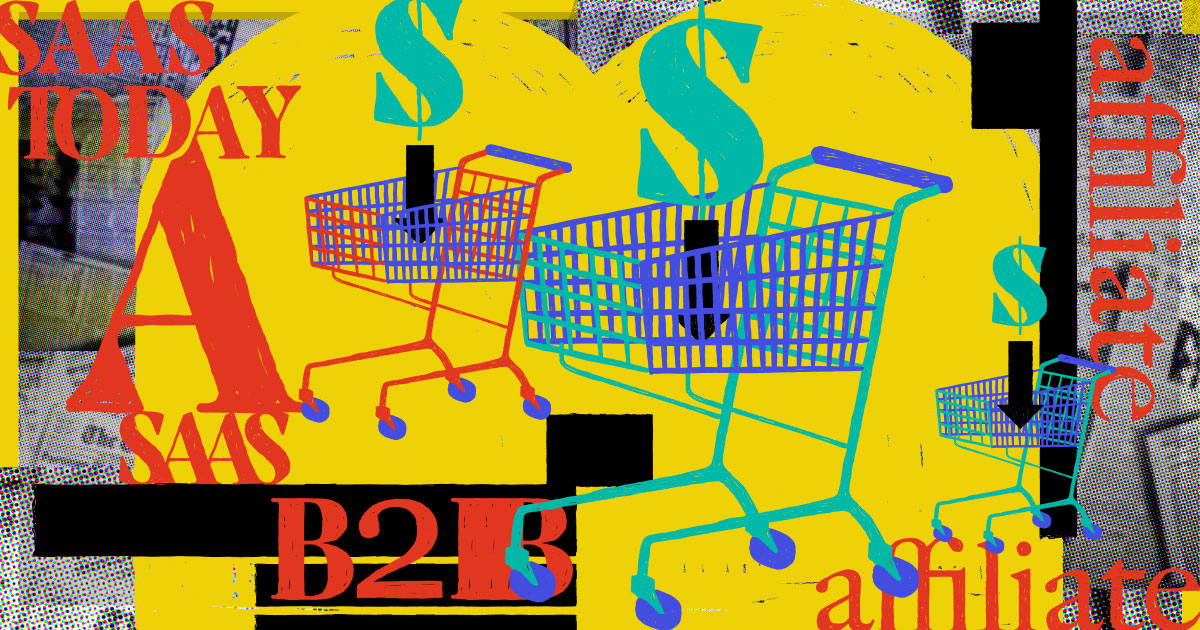You’ve definitely seen the phrase “This video/article has been sponsored by…” somewhere during your internet exploration. The rise of affiliate marketing has taken over YouTube, blogs, and even news websites. While affiliate marketing predates the internet, the rise of technology made it a $12 billon dollar industry. In the B2B world, there’s a mountain of benefits to this type of marketing… But how do you tap in? We spoke with PartnerStack’s Director of Network Growth Andy Kim to get into how beginner affiliates and brands can start generating revenue and maintain successful relationships.
The beginner’s guide to B2B affiliate marketing
First, let’s level-set on what exactly affiliate marketing is and why it’s so valuable.
What is affiliate marketing and why is it relevant?
Affiliate marketing is an advertising method that offers financial incentive for digital publishers, content creators, and other third-parties to promote a brand’s service or product. The digital publisher — that could be an influencer with a popular YouTube channel, a blog, a podcast, a website — promotes a product or service and earns a commission based on the sales or leads that the advertising generates.
Why market through affiliates? Software purchasing is expensive and risky. If purchasing organizational software is your job, it’s hard to know whether your choice to buy is the right choice. As Kim puts it, when you’re buying for a B2B organization, the wrong technology “could put you back tens of thousands of dollars while resulting in ineffective results.”
The influence of affiliates on consumer purchasing decisions
Because of the high-stakes software purchasing game, B2B professionals rely heavily on reviews and word of mouth from people who’ve used the software in the past. That’s where affiliates come in. Affiliates work as influencers and mouthpieces for your business, identifying key solutions to their (and your) audience. “Affiliates are the ones who are going to talk about those things, they’re going to be the ones that do the reviews, and talk about your product in a more neutral setting,” notes Kim.
The added value of an affiliate network comes from that last point. The fact that praise for a product is coming from an independent publisher having experience with the product rather than an internal source stands out to buyers. Consider your connection to an affiliate (and their audiences) a bridge of trust. When a client sees that an affiliate they recognize and trust believes in a product, they're more likely to see it as a seal of approval, meaning they’re more likely to trust the brand and purchase the product.
It also creates another point of contact between you and your audience. While ads and email campaigns help get your products in front of clients’ eyes, there’s an added layer of credibility of hearing it from a trusted third party.
Furthermore, affiliates can help businesses reach new audiences by tapping into their niche. It may be an audience that’s just out of reach of your brand, or it may be an audience that simply needs to see your product in a new light. Although traditional campaigns are great, sometimes it just takes a new format to see the value in your product. Besides, according to Demandbase, 91 per cent of every B2B purchase is influenced by word of mouth in some way.
“It’s a goldmine for B2B businesses to create an extension of their brand, from someone who already has the influence and trust of an audience,” says Kim. “People are far more likely to trust content creators than businesses that talk about themselves.” It’s a win-win.
See more: The year's top affiliate content.
.jpg)
How do I build an affiliate base, and what tools will I need?
While relying on affiliate marketing seems to be a slam dunk for B2B brands, how do you create a base of trusted affiliates? It might seem obvious to target the influences with the largest audience, but there’s a better way to go about it. While seeking an influencer in the niche is the obvious answer, Kim says that B2B businesses should think about the customer they want to reach before starting the affiliate search. “Who is your persona that you need to get in front of, think about who can reach that, whether it’s their content or relationships, and that will help you build your ideal partner profile and directly relates to your business,” he explains. As always, the first step is to think about your end user, and get creative with connecting them to your product. “You’d be surprised at the results you might get from that approach,” Kim notes.
Choose the right partner relationship management software
Before you set out to conquer the world of affiliate marketing, there’s a few things you’ll need. Kim says the first is a partner relationship management software (PRM), like PartnerStack, that allows you to keep track of all partners’ needs and progress, saving marketers a ton of stress and time. “You need to manage the relationship between your partners, because at the end of the day, it’s a very intimate thing; you’re building an extension of your business,” says Kim. “You need a platform that can help you manage your partners, engage your partners, as well as pay your partners on time.”
Speaking of partner management, you should have someone on your team who can lead the charge for your affiliate marketing program. Partnerships managers usually come from sales or marketing teams, or you can aim to hire someone with previous experience. Just look for someone with the right skills and enough bandwidth to get the program up and running.
Where can I find affiliates, and how do I recruit them?
There are two ways to think about the recruitment process when it comes to affiliates. First up is inbound, which means partners come to you. This starts by building your partner program a dedicated landing page that explains who you’re looking for, who you’re trying to reach, how much affiliates can earn and other basics of the program. That way, affiliates who want to work with your brand have a red carpet straight to you.
The other method of recruitment is the outbound approach, which means the brand goes out and does the recruiting itself. This method requires a little more effort and a handful of other tools. Kim recommends investing in an SEO tool like SEMRush that can help find affiliates that are already using affiliate links. Other tools, like Respana, list out publishers and break them down by sector and industry. “There’s a management piece and a recruitment piece that you need, but it starts with the PRM,” says Kim. “You need a really strong PRM to anchor you down from an engagement, management, and payment perspective. That's the way you should build a program from scratch.”
Read more: Inbound vs outbound partner recruitment and strategies for each.
.jpg)
Now that you have all the tools needed to reel in affiliates, here’s how you can start generating income. There’s a handful of ways affiliates can earn commission:
- Pay per click: payment based on how many clicks your affiliate’s unique link generates
- Pay per action: payment upon the creation and publication of blog posts or videos
- Pay per call: payment based upon the amount of calls the brand receives based on your leads
- Pay per lead: payment based on qualified potential clients that make their way from the affiliate to your brand
- Pay per installation: payment based on however many clients ultimately install the software
- Pay per sale: in which affiliates get paid as users buy or renew software licenses
Kim notes that B2B enterprises typically use pay per sale as their commission system. “That’s the direct relationship between the revenue that they’re generating, and the amount they’re paying their partners.”
Keeping up with your affiliates’ success
In order to keep up a lean and efficient affiliate system, there’s two main factors that B2B marketers should be aware of: volume and conversion rates.
Link clicks are great, but from a B2B perspective, what really matters is how many customers your affiliate is generating for you. “What percentage of those customers are actually converting into paid customers, AKA revenue for you?” questions Kim.
So, a $50 commission being paid out to a partner, for example, should be compared to how much revenue is taken in. It’s almost like managing your ROI on a per partner basis. “I would definitely encourage people to take a look at those things on a partner by partner level to understand whether or not your commission structure is actually a viable model for the business,” says Kim.
Kim adds that business-related affiliate programs typically have the highest conversion rate and the highest payout rate. “I would definitely encourage affiliates to really think about that, because I think it’s a great starting point for finding ways to really start bolstering the income that you're earning from the work that you're doing.”
Like we said, a true win-win.











